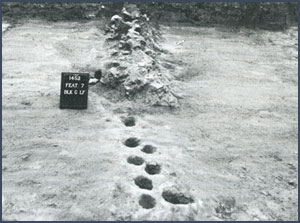What is a Posthole?
Example of postholes that have been excavated by archaeologists. These postholes (and others not shown) indicate where a Pueblo house once stood. At an archaeological site, a posthole is a small, round, dark stain that formed when a wooden post or pole rotted or burned in the ground. Postholes arranged in a large circle, oval, or rectangle indicate where a house or other structure may have stood. Postholes arranged in a straight line might be the remains of a windbreak, sunscreen, drying rack, loom, or other small construction. Archaeologists carefully document the locations, sizes, and patterns of postholes so they can reconstruct what a site or building looked like in the past. |
 DONATE TODAY
DONATE TODAY
